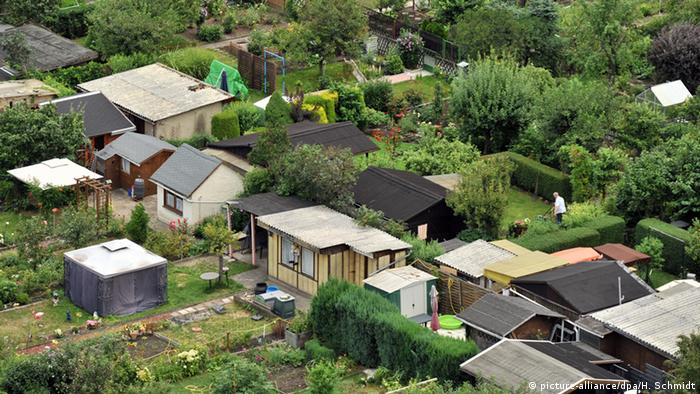By Anna Sauerbrey, The New York Times, August 9, 2018
BERLIN — It’s quiet in Germany. School’s out, Chancellor Angela Merkel is on vacation and the country is recovering from the latest government crisis.
So where is everybody? Judging from my Instagram account, some Germans are hiking the Alps, or visiting temples in Myanmar. But Germany’s summertime soul is in its Kleingärten — literally “small gardens.” That’s where we are. That’s what we are. And that’s where you can see the country change.
This being Germany, what counts as a Kleingarten is defined in the “Bundeskleingartengesetz,” or “Federal Small Garden Law”: A Kleingarten (“Kleingärten” in the plural) is a garden of no more than 400 square meters (478 square yards) that is used for noncommercial subsistence gardening and recreation; it must be part of an agglomeration of at least five gardens that also encompasses communal areas and facilities, the Federal Court of Justice has ruled. You can find them outside villages or next to urban parks or squeezed into the Neverland between railways and housing. Sometimes, there’s just a few. Sometimes, there are hundreds.
Kleingärten are not confined to, but have always had a particularly important function for, the cities. In the industrializing, rapidly urbanizing 19th century, they were a refuge for poor workers who had to live in overcrowded and gloomy apartment buildings. Crops from small gardens helped the city’s poor to survive the economic crisis that followed World War I. They were where people slept after they were bombed out during World War II. They were where Eastern Germans grew the strawberries they could not buy in the Communist regime’s economy of scarcity.
In the postwar West, however, they have always been a luxury. They became the place where the urban petty bourgeoisie could act out its dream of perfect orderliness. The Kleingarten is a German cliché: narrow but perfectly ordered, shrewd but likable, above all an idyll amid the swirling roughness of the world.
Or at least it used to be. The Kleingarten is getting caught up in a massive urban conflict: the fight over space.
Take, for example, Bornholm I, a colony of small gardens in Berlin’s Pankow district. A colleague of mine, Robert Ide, is a tenant there — and has recently been appointed deputy head of the board of the club that runs the gardens.
Only 10 years ago, it would have been very unlikely to find someone like Robert in a Kleingarten club: a journalist with a university degree, who lives in a cool area of Berlin with his girlfriend and two small children. The Kleingärten used to be sniffed at by the urban elite — too square, too uncool, too full of garden gnomes.
But driven by the ecological movement, rising housing prices and smaller apartments, families like Robert’s have discovered the gardens. Like many others, Robert, too, is seeking a timeout from his stressful job. He wants his kids to learn about nature, and he wants a safe place for them to play. “It’s so relaxing to dig a bed, or to cut a tree,” he told me. “In the garden, I can really forget about everything.”
However, the changes in the social mix of the club did not go without debate. All the lines of tension in German urban society crossed in the Kleingarten. “It was the older folks against the younger ones, Easterners against Westerners, the newly arrived against long time Berlin residents,” Robert said.
While many new gardeners wanted to open the area to nonmembers, and envisioned the gardens as a space for neighborhood meetings and festivities, many of the older ones insisted on privacy and closed gates. Some of the older and less well-off members had been pushed out of gentrifying neighborhoods like Prenzlauer Berg; now those who had driven up the rents became their garden neighbors.
The tensions in Bornholm I were exacerbated by outside changes, too. The Berlin State Senate has promised to control the rising housing prices in the city and build 30,000 apartments in the next three years. The Senate is looking for cheap land to develop, and much of the land occupied by Kleingärten is city land. Berlin’s government is considering turning some into housing developments. Bornholm I is said to be on the list.
At first, Pankow’s small gardeners were divided over how to respond. But eventually the outside threat had a unifying effect, Robert said. Together, they persuaded the Pankow district administration to lobby the Senate to protect Kleingärten areas from development. Similar stories, playing out in other Kleingärten, have led to a citywide campaign to save them.
Conflict over how to share the city’s limited space is the future, and not just in Berlin. Germany’s Kleingärten may no longer be a necessity for struggling urban dwellers, but they still give urbanites a desperately needed connection to nature. But it takes more than just yard work to make them function: We have to share our precious urban communal space with others, we have to follow its rules.
In this urban world of scarcity and constraints, Germany’s Kleingärten have turned from symbols of conformity into places of individuality, creation and empowerment — and, at least at Bornholm I, a place where people with very different backgrounds and worldviews can labor side by side. Not all of them will survive the housing crisis. But the fight will be fierce.
In this urban world of scarcity and constraints, Germany’s Kleingärten have turned from symbols of conformity into places of individuality, creation and empowerment — and, at least at Bornholm I, a place where people with very different backgrounds and worldviews can labor side by side. Not all of them will survive the housing crisis. But the fight will be fierce.

No comments:
Post a Comment